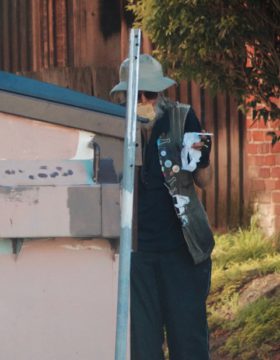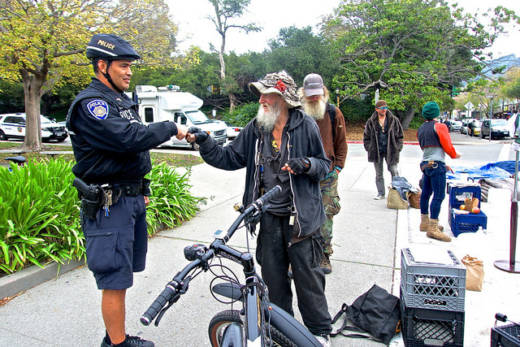Hate Man was born in Washington, D.C., grew up in Stamford, Connecticut, and served in the Air Force and the Peace Corps. He started work as a copy boy at the New York Times in 1961 and eventually rose -- with some time off in Thailand -- to be a metro reporter.
But Hate Man grew tired of the conventional 9-to-5 life and moved to the Bay Area in 1973. For about 13 years he lived in a studio near Telegraph Avenue. During this time he adopted his philosophy of “oppositionality.” He believed that people would feel safe together if they rubbed one another the wrong way first. He started telling people “I hate you,” as a greeting or knocked up against them, either with a fist bump or a shoulder bump. Hate Man stood in an empty fountain on Sproul Plaza the first year of his “preaching,” according to the Express.
“For me to trust a person and be comfortable with them, they have to be willing to say ‘I hate you,’” Hawthorne told the Mercury News.
Hate Man was famous enough that he had a Wikipedia entry that explained his philosophy this way: “The idea is to avoid negative conflict by bringing such differences out in the open, rather than creating situations where people rob or con one another for what they want.” CBS News did a segment on him in 1997, and there were numerous newspaper articles written about him. His former employer, the New York Times, ran a column about him in 1991. He is also depicted in a mural at People’s Park.
Hate Man had been suffering from heart problems this year, according to Sally Hindman, the director of Youth Spirit Artworks. He had been hospitalized three times and had heart surgery, she said. His heart apparently gave out Sunday evening.
As evidenced by the accolades pouring in, Hate Man was a beloved figure in Berkeley.
“Hate Man ... you will always be an utter Berkeley treasure,” Hindman wrote on Facebook. “Sooooo many of us will miss you absolutely hugely, when we go up to People’s Park, or to Sproul Plaza, or just when we think of you ... but we will think of you & it will bring giant smiles to our faces. Hate, you were FUN, you were loving, you were hysterically funny and delightful. You made us question our own inner feelings whenever we said HELLO … and how profound that was!!”
“The Hate Man, as he called himself, thought through a way of communicating with others based on honesty, sharing, dissipating anger by expressing it, and not being satisfied with the way things are,” John Schott, a guitarist, wrote on Facebook. “I was forever altered by my encounters with the practice he developed.”
"Talk about someone who lived his life on his own terms,” said Tom Dalzell, the labor lawyer who does the “Quirky Berkeley” website.
A number of the remembrances included expressions of hate -- just as the Hate Man would have wanted. The Hate Man Foundation (Hee hah) Facebook group has numerous posts and photos by his friends.
Hate Man is survived by a sister and two daughters.
Friends of Hate Man will gather under his favorite acacia tree tonight, Monday, April 3, at People’s Park at 6 p.m. to remember him and discuss a way to honor him, according to McMullan on his Facebook page.
Follow Berkeleyside on Twitter and Facebook or get the latest news in your inbox with Berkeleyside’s Daily Briefing. Email us at tips@berkeleyside.com. Keep Berkeleyside running and support independent local journalism by becoming a member.

